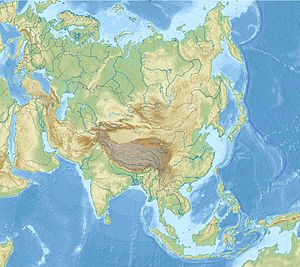Dushanbe
Душанбe | |
|---|---|
Dushanbe skyline Statue of Rudaki | |
 Location of Dushanbe in Tajikistan | |
| Coordinates: 38°32′12″N 68°46′48″E / 38.53667°N 68.78000°E | |
| Country | |
| Region | Dushanbe |
| Named for | Monday |
| Districts | List
|
| Government | |
| • Shahrdar (Mayor) | Rustam Emomali (PDPT) |
| Area | |
| • Land | 203 km2 (78 sq mi) |
| • Urban | 185 km2 (71 sq mi) |
| Elevation | 823 m (2,700 ft) |
| Highest elevation | 930 m (3,050 ft) |
| Lowest elevation | 750 m (2,460 ft) |
| Population (March 2024) | |
| • Capital city | 1,564,700[1] |
| • Rank | 1st in Tajikistan |
| • Metro | 3,147,000[1] |
| Time zone | UTC+05:00 (Tajikistan Time) |
| • Summer (DST) | (Not Observed) |
| Postal code | 6-Digit |
| Area code | 372[3] |
| Vehicle registration | 01, 05[6] |
| HDI (2021) | 0.756[7] high |
| Official languages | |
| Website | www |
Dushanbe[a][b] is the capital and largest city of Tajikistan. As of March 2024[update], Dushanbe had a population of 1,564,700, with this population being largely Tajik. Until 1929, the city was known in Russian as Dyushambe,[c] and from 1929 to 1961 as Stalinabad,[d] after Joseph Stalin. Dushanbe is located in the Gissar Valley, bounded by the Gissar Range in the north and east and the Babatag, Aktau, Rangontau and Karatau mountains in the south, and has an elevation of 750–930 m. The city is divided into four districts: Ismail Samani, Avicenna, Ferdowsi, and Shah Mansur.
In ancient times, what is now or is close to modern Dushanbe was settled by various empires and peoples, including Mousterian tool-users, various neolithic cultures, the Achaemenid Empire, Greco-Bactria, the Kushan Empire, and Hephthalites. In the Middle Ages, more settlements began near modern-day Dushanbe such as Hulbuk and its famous palace. From the 17th to early 20th century, Dushanbe grew into a market village controlled at times by the Beg of Hisor, Balkh, and finally Bukhara, before being conquered by the Russian Empire. Dushanbe was captured by the Bolsheviks in 1922, and the town was made the capital of the Tajik Autonomous Soviet Socialist Republic in 1924, which commenced Dushanbe's development and rapid population growth that continued until the Tajik Civil War. After the war, the city became capital of an independent Tajikistan and continued its growth and development into a modern city, today home to many international conferences.
Much of Dushanbe's education system dates from Soviet times and has a legacy of state control; today the largest university in Dushanbe, the Tajik National University, is funded by the government. Dushanbe International Airport is the primary airport serving the city. Other forms of transport include the trolleybus system dating from 1955, the small rail system, and the roads that traverse the city. Dushanbe's electricity is primarily hydroelectric, produced by the Nurek Dam, and the aging water system dates from 1932. Tajikistan's healthcare system is concentrated in Dushanbe, meaning that the major hospitals of the country are in the city. The city makes up 20% of Tajikistan's GDP and has large industrial, financial, retail, and tourism sectors. Parks and main sights of the city include Victory Park, Rudaki Park, the Tajikistan National Museum, the Dushanbe Flagpole, and the Tajikistan National Museum of Antiquities.
- ^ a b "ШУМОРАИ АЊОЛИИ ЉУМЊУРИИ ТОЉИКИСТОН ТО 1 ЯНВАРИ СОЛИ 2022" (PDF). 2022. Archived from the original (PDF) on 10 October 2022. Retrieved 3 February 2023.
- ^ Cite error: The named reference
Вечёрка-2020was invoked but never defined (see the help page). - ^ a b "About Dushanbe". U.S. Embassy in Tajikistan. Retrieved 1 August 2020.
- ^ M., Davidzon (1983). Dushanbe, a guide. Raduga. OCLC 11399951.
- ^ Cite error: The named reference
Dushanbe-2021awas invoked but never defined (see the help page). - ^ "License Plates of Tajikistan". worldlicenseplates.com. Retrieved 28 July 2021.
- ^ "Sub-national HDI – Area Database – Global Data Lab". hdi.globaldatalab.org. Retrieved 13 September 2018.
- ^ "КОНСТИТУЦИЯ РЕСПУБЛИКИ ТАДЖИКИСТАН". prokuratura.tj. Parliament of Tajikistan. Retrieved 9 January 2020.
- ^ "General information about Dushanbe | Conference on Interaction and Confidence Building Measures in Asia". Conference on Interaction and Confidence-Building Measures in Asia. 30 July 2020. Archived from the original on 30 July 2020. Retrieved 16 January 2021.
The village Dushanbe arose at the crossroads. On Mondays big bazaars would be organized, which is where the village inherited its name "Dushanbe", meaning "Monday".
- ^ Saĭmiddinov, Dodikhudo; Kholmatova, S. D .; Karimov, S.; Kapranov, V. A . (2006). Farḣangi tojikī ba rusī : 70 000 kalima va ibora [Tajik-Russian dictionary: 70,000 words and phrases]. Dushanbe: Academy of Sciences of the Republic of Tajikistan, Rudaki Institute of Language and Literature, Scientific Center for Persian-Tajik Culture. OCLC 76271036.
- ^ "Tajikistan". The World Factbook. CIA. Retrieved 30 January 2020.
etymology: today's city was originally at the crossroads where a large bazaar occurred on Mondays, hence the name Dushanbe, which in Persian means Monday, i.e., the second day (du) after Saturday (shambe)
- ^ Tajik National Encyclopedia (PDF). p. 272. Archived from the original (PDF) on 8 April 2022. Retrieved 2 September 2021.
Cite error: There are <ref group=lower-alpha> tags or {{efn}} templates on this page, but the references will not show without a {{reflist|group=lower-alpha}} template or {{notelist}} template (see the help page).









